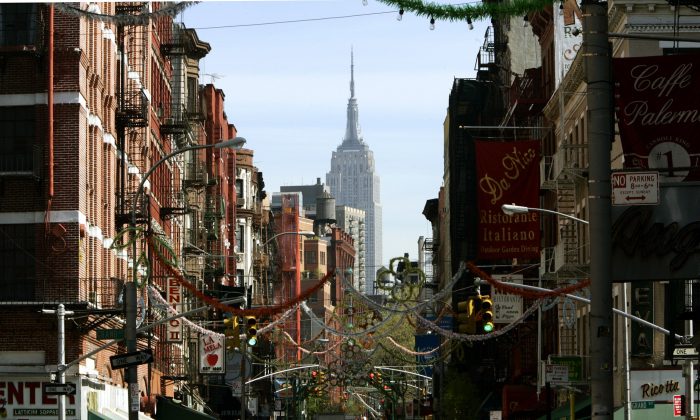A debate has arisen between park supporters and homeless advocates regarding the proposed sale of a public space to a developer aiming to construct housing for seniors and the homeless. The pending sale of the Elizabeth Street Garden in Manhattan’s Little Italy neighborhood has sparked efforts to save the park, including open letters from celebrities urging Mayor Eric Adams to reconsider.
The city remains steadfast in its decision to proceed with the sale, with plans to replace the park with a seven-story housing complex that includes units for senior and homeless residents. Despite legal challenges and grassroots opposition, the city’s plans have been upheld in court, leading to disappointment for those advocating for the preservation of the park.
Supporters of the park, including nonprofit organizations and advocacy groups, are working tirelessly to save the green space. They argue that while affordable housing is important, alternate sites with similar dimensions could be considered for development instead.
Celebrities such as Martin Scorsese, Robert De Niro, and Patti Smith have voiced their support for preserving the park, citing its unique cultural and historical significance. They emphasize the importance of maintaining green spaces in dense urban areas like Little Italy.
The park’s defenders highlight its role as a community gathering place and a rare oasis in a crowded neighborhood. They argue that losing the Elizabeth Street Garden would deprive the community of much-needed green space and recreational opportunities.
It is heavily used by neighbors, small businesses, visitors from other neighborhoods, and tourists from around the world,” Kiely said.
Joseph Reiver, executive director of the nonprofit that shares its name with the park, also sees the park as a magnet for visitors from all over.
“We get over 200,000 visitors a year, which is highly significant in terms of square footage. And with the news right now, everyone’s very concerned. We’re getting a heavy volume of people coming in to see how they can help,” Reiver told The Epoch Times.
Currently, a volunteer force of 480 people from various parts of the city, including Brooklyn, Queens, and the Bronx, are helping maintain the park and keep it attractive for the strong inflow of visitors, he said.
“We have been engaged in this lawsuit since 2019, based on environmental implications,” Reiver said.
“That case went all the way to the Court of Appeals, but unfortunately, we lost that case. That’s why this kind of red alert is happening right now; the city is attempting to move forward,” he said.
Both Kiely and Reiver point to the availability of other sites that would be suitable for building more housing.
Keily does not credit the argument that either housing for seniors and the homeless or the park must receive priority.
“This is a false choice. Friends of Elizabeth Street Garden identified several alternative locations in our community where up to five times as much housing can be built—for example, at 388 Hudson Street and the federally owned parking garage at 2 Howard Street,” she said.
The Manhattan Community Board, on which Kiely serves, has argued in favor of constructing new housing units at 388 Hudson Street, Kiely said. This location has been under consideration as a possible housing site for more than two decades, but according to Kiely, the city told her and her colleagues that building units there would take too long.
“The city is finally moving forward, but this housing could already have been built,” she said.
Reiver said that supporters of Elizabeth Street Garden are not against building units in the same neighborhood. He said he had personally submitted a proposal that, if put into action, would result in a building with more units than the plan to replace the park with affordable housing currently envisions.

Director Martin Scorsese at an event at the Egyptian Theatre in Los Angeles on Dec. 3. Jonathan Leibson/Getty Images for Paramount Pictures
Dueling Imperatives
Rosemarie Ruggero, founder and CEO of ElderCare Advocacy, a New York-based geriatric care provider, said part of the resistance to selling the park to a developer and paving the way for affordable housing may stem from a lack of concern for senior citizens as compared to other segments of the population.
Some people may assume that the plan is another phase in the chronic mishandling of the city’s illegal immigrant crisis and a case of misplaced priorities, she said.
“People in the area may not believe that a new building would provide housing for the elderly as much as it would for the homeless. With the influx of immigrants and the negative exaggeration of ‘immigrant crime,’ people don’t want ‘affordable housing’ or homeless shelters next door,” Ruggero told The Epoch Times.
“Of course, it is assumed that property values would decrease as well.”
The city has experienced an inflow of more than 200,000 illegal immigrants since the spring of 2022 and has a persistent homelessness problem. The battle underway over the fate of Elizabeth Street Garden is familiar to people who have studied and grappled with the issue of homelessness.
“There is a constant urban dilemma; namely, creating new developments versus preserving urban spaces such as historical landmarks, old housing units, or, in this example, green spaces,” Clark told The Epoch Times. His HomeMore Project is a San Francisco-based nonprofit that seeks solutions to the homelessness crisis.
In places with large homeless populations, such as San Francisco, Los Angeles, and New York, the expression “sprawl hits the wall” has become common, Clark said, adding that this phrase denotes a situation where the urban core has ceased to expand space at a premium.
In such circumstances, it is important to consider the moral and strategic rationales for new developments on a case-by-case basis, Clark said. He pointed to the example of San Francisco, a city with a large number of vacant parking garages and office spaces. In such instances, he favors policies that convert the spaces into housing for the homeless, the poor, senior citizens, needy families, and other vulnerable segments of the population.
However, in the case of public spaces with far more cultural, historical, and social importance, such as Golden Gate Park, Clark said he would not advocate conversion, even for a goal as beneficent as providing housing for the undomiciled.
“To me, it comes down to the dynamics of the community and trying to get to the closest possible hypothetical line of the neighborhood’s needs and wants: the ‘needs’ being people in need of housing, the ‘wants’ that people want desirable amenities where they live. It can’t be only about housing,” he said.
Municipalities should look into whether they are making the most economical use of the space that they allocate for housing, Clark said. One solution is upzoning, which removes restrictions on the height and number of units within a building, he said. This solution has its share of advocates in certain areas of San Francisco, but again, it is necessary to review all such prospects on a case-by-case basis, he said.
“I believe there needs to be a balance between developments that meet the housing needs of the community while also preserving the amenities that are important reasons why people choose to live in those communities,” Clark said.
Adams’s office did not respond to a request for comment by publication time.





